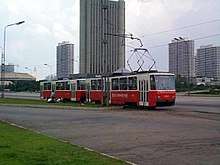Trams in Pyongyang
 Older Tatra T6B5 vehicles on tram line 1 | |||
| Overview | |||
|---|---|---|---|
| Locale |
| ||
| Transit type | Tram | ||
| Number of lines | 4 | ||
| Line number | 1, 2, 3, Kumsusan | ||
| Operation | |||
| Began operation | 1989 | ||
| Operator(s) | Transport and Communication Commission | ||
| Character | At-grade | ||
| Train length | 1-2 bi-articulated vehicles | ||
| Technical | |||
| System length | 53.5 km (33 mi) | ||
| Track gauge |
1,435 mm (4 ft 8 1⁄2 in) 1,000 mm (3 ft 3 3⁄8 in) | ||
| Electrification | Overhead DC 600V, 20 A; up to 200 A during acceleration | ||
| Average speed | 30 kilometres per hour (19 mph) | ||
| Top speed | 60 kilometres per hour (37 mph) | ||
| |||
| Pyongyang Tram | |
| Chosŏn'gŭl | 평양 궤도전차 |
|---|---|
| Hancha | 平壤 軌道電車 |
| Revised Romanization | Pyeongyang gwedojeoncha |
| McCune–Reischauer | P'yŏngyang kwedojŏnch'a |


Pyongyang Tram is a public tram system in Pyongyang, the capital of the Democratic People's Republic of Korea (North Korea).
Overview
In the pre-war era, there were three tramways in Korea: Seoul, Busan, and Pyongyang. However, the system in Pyongyang was discontinued after the Korean War of 1950 to 1953. Those in Seoul and Busan survived the war, but were discontinued when motor cars became more common in South Korea in 1968, leaving no tramways on the peninsula.
Unlike South Korea, personal ownership of automobiles in Pyongyang is very rare. North Koreans rely mainly on public transport. As oil imported into the country is mostly allocated to its military, Pyongyang has electrically powered trolleybuses (Pyongyang trolleybus system) and subways (Pyongyang Metro) as its main public transport. However, as trolleybus lines became overcrowded, the city decided to build tram lines. The first line opened in 1989.[1]
In the late 1990s, the city had frequent power outages due to decrepit power stations and the lack of resources. The tram lines also suffered from outages, but the situation has improved in recent years. In 2003, however, the section of Line 1 between P'yŏngyang-yŏk and Songsin was closed, as the bridge over Taedong River started to decay.
In 2008, the City Transportation Company of Prague sold 20 used T3s to Pyongyang Public Transportation Enterprise together with a shipment of tram-rails. These trams were made in the late 1970s and the early 1980s. According to Ondřej Pečený, a spokesman for the City Transportation Company of Prague, these trams are in very good condition, and can run for at least two years without the need of a service. The tram cars were made by Tatra, a Czechoslovak company, during that nation's socialist era. Various types are used, but there are currently no low-floor tram cars.
Foreign tourists were previously not permitted to ride the tram lines, but some recent tours have started to include tramway rides (though rides are not shared with locals and are instead chartered, unlike the Pyongyang Metro).[1]
Lines
There are currently four lines in operation.
- Line 1: P'yŏngyang-yŏk (평양역; 平壤驛) — Man'gyŏngdae (만경대; 萬景臺)
- Line 2: T'osŏng (토성; 土城) — Rangrang (락랑; 樂浪) — Munsu (문수; 紋繡)
- Line 3: Sŏp'yŏngyang (서평양; 西平壤) — Rangrang (락랑; 樂浪)
- Kŭmsusan: Service to Kŭmsusan Palace of the Sun (no transfer to other lines)
As of 2006, the fare is ₩5 for any section. There are also coupon tickets (시내 차표; 市內車票; sinae ch'ap'yo).
Rolling stock
In August 2018, new domestically-produced tram cars were introduced in Pyongyang for the first time in decades.[2] These new cars follow the introduction of new trolleybuses and metro cars.
The cars were recently installed along the Kwangbok (Liberation) Street line and connect to Pyongyang Station. It is unclear how many new cars have been added to the line.
The new domestically-produced tram vehicles add LED destination displays but do not appear to include air-conditioning. The trams were manufactured by Pyongyang's Bus Repair Factory under the domestic brand Songsan, assembled mostly, but not entirely, with domestic parts.[1]
Before the introduction of new rolling stock, the only rolling stock used was Czechoslovakian ČKD Praha Tatra T6B5 and KT8D5K, in typical red/white livery.[1] The Kŭmsusan line uses VBZ Be 4/4 Type Ib rolling stock, on a different gauge of 1,000mm, rather than 1,435mm for lines 1-3.

See also
References
- 1 2 3 4 "New tram cars appear on Pyongyang's Liberation Street line | NK News - North Korea News". NK News - North Korea News. 2018-07-31. Retrieved 2018-09-14.
- ↑ "개발창조형의 궤도전차 생산" [Domestic creation of tramcar production]. Sogwang (in Korean). 2018-08-14. Retrieved 2018-09-14.
Further reading
- Hayato Kokubu, Shōgun-sama no Tetsudō: Kitachōsen Tetsudō Jijō (将軍様の鉄道 北朝鮮鉄道事情; "Railway of the Dear Leader: The Railway Situation in North Korea"), 2007. ( ISBN 4103037318)
External links
| Wikimedia Commons has media related to Trams in Pyongyang. |
